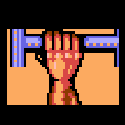|
JHVH-1 posted:Setting up vsftp isn't that hard. On Ubuntu server anonymous is enabled, so you want to change that to NO and then change local users to YES and value to chroot local users to YES, unless you only want to chroot certain users. In that case you set the chroot file to some place in /etc/, create the file with an editor and put the users you want to chroot on it. I think thats about it.
|
|
|
|

|
| # ? Jun 2, 2024 01:03 |
|
Can anyone recommend a HTTP downloader for linux that is accessible through a WebGUI. Something like 'Free Download Manager' for windows would be perfect. I'm building a linux server to mess around with. I've got SABnzbd for usenet, but so far I've only found wget4web for http downloads which doesn't have any handy features I need like scheduling. edit: bonus points if it does torrents aswell, but I know a couple of programs that I could use for that. Stokesy fucked around with this message at 05:49 on Sep 15, 2009 |
|
|
|
There sure are a lot of people who need to keep downloading those Linux ISOs long after they've installed Linux. 
|
|
|
|
Accipiter posted:There sure are a lot of people who need to keep downloading those Linux ISOs long after they've installed Linux. some people like to experiment with different distros. or their downloading freeware/demos.
|
|
|
|
kcncuda71 posted:some people like to experiment with different distros. or their downloading freeware/demos. or ISOs from MSDN to play around with on test machines to mix it up a bit.
|
|
|
|
I'm running some UNIX/Linux servers at home right now as web/email/file/etc servers to provide basic network services to my roommate and friends. Most of these people either don't know what Linux is, or can't be bothered to learn anything about it, but I would like to be able to provide them with user-friendly access to their accounts on the servers. I know enough PHP to set up a basic user account management application, but I'm interested in using it to control the actual Linux user accounts, since these are the accounts used to access most of the network services (email, samba/nfs file sharing, etc). I know allowing apache the ability to change files and run programs is not a route I really want to take for security reasons, but I assume there's a way to do this considering all of the hosting control panels available (cPanel, etc) that seem to do this. What is the preferred (and secure) method for allowing a php or other web-facing application access to changing user passwords and viewing user account details? I'd rather not install a full blown hosting control panel, since I just want my users to be able to change their passwords without telling me or logging in via ssh and running passwd.
|
|
|
|
baalzamonbarnes posted:I'm running some UNIX/Linux servers at home right now as web/email/file/etc servers to provide basic network services to my roommate and friends. Most of these people either don't know what Linux is, or can't be bothered to learn anything about it, but I would like to be able to provide them with user-friendly access to their accounts on the servers. I know enough PHP to set up a basic user account management application, but I'm interested in using it to control the actual Linux user accounts, since these are the accounts used to access most of the network services (email, samba/nfs file sharing, etc).
|
|
|
|
I'm going to be reinstalling XP on my netbook and completely deleting UNR in the process When I'm done, will I have to fix the mbr, and how will I do that
|
|
|
|
Dickeye posted:When I'm done, will I have to fix the mbr, and how will I do that Boot the XP install CD to the recovery console and try fixboot or fixmbr
|
|
|
|
Bob Morales posted:Boot the XP install CD to the recovery console and try fixboot or fixmbr so install it, boot the CD again, and go into the console got it
|
|
|
|
Trick question, XP will trash your MBR without asking
|
|
|
|
Misogynist posted:Trick question, XP will trash your MBR without asking Even better! I don't plan on using Ubuntu again (unless when Karmic rolls out, UNR has the option to install from Wubi and I can actually partition my drive)
|
|
|
|
Does anyone have a recommendation for a music server with a web interface that can run on a headless server? I've got a Debian box running as a file server, with SABnzbd+ on it as well, but I'd like to also make it so that rather than just sharing my music and playing it locally in winamp I can connect to it remotely from any computer and play music as if it were a music repository. I don't know if this request makes any sense, I'm basically asking if there's software that creates a dedicated "music" server separate from Samba.
|
|
|
|
teamdest posted:Does anyone have a recommendation for a music server with a web interface that can run on a headless server? I've got a Debian box running as a file server, with SABnzbd+ on it as well, but I'd like to also make it so that rather than just sharing my music and playing it locally in winamp I can connect to it remotely from any computer and play music as if it were a music repository. I don't know if this request makes any sense, I'm basically asking if there's software that creates a dedicated "music" server separate from Samba. I personally prefer MPD. There are a large number of clients and web interfaces designed for it, and it allows streaming of your music over a network. It is somewhat a pain taking care of all the dependencies but once it is setup it is definitely worth it.
|
|
|
|
teamdest posted:Does anyone have a recommendation for a music server with a web interface that can run on a headless server? I've got a Debian box running as a file server, with SABnzbd+ on it as well, but I'd like to also make it so that rather than just sharing my music and playing it locally in winamp I can connect to it remotely from any computer and play music as if it were a music repository. I don't know if this request makes any sense, I'm basically asking if there's software that creates a dedicated "music" server separate from Samba.
|
|
|
|
here's one that's probably easy. I have a downloads folder in the home directory, and I want every file and folder that goes in there to be chmod 777 automatically... Right now I have to do a recursive chmod, and every time I have a new file, have to do it again. How do I make the 777 permissions stick?
|
|
|
|
If you have ACL support the easiest way is to do a setfacl -m default:group:owner:2777 /path. This will only apply to new files and will not apply to files copied from elsewhere. Those files will retain their permissions.
|
|
|
|
tablebreaker posted:here's one that's probably easy. Obligatory nannying of "are you suuuuure they need to be 777 and not something more restrictive?"...there are valid reasons for 777 but they're relatively uncommon and it's a terrible habit to form. Misogynist is right that ACLs may help here, but assuming you're copying files into that folder by hand somehow, you'd probably need something awful like a cronjob that runs every minute and performs the chmod. This again raises the question of what exactly you're doing, because there's probably a better answer (i.e. if files are arriving there via a tool like a torrent app, it may have conf options for this; ditto if a Web app is putting them there; etc; what is it that needs to read these files that they have to be 777, because it may be easier to approach that specifically; etc etc.) For example, a almost-complete solution I have for multiple users and the Web server being able to modify stuff in an Apache docroot is to ensure all users involved have the Apache group as their primary login group, then modify their bashrcs with a umask call, such that their files become group-writable by default. Thus, when I or the others create files via SVN up or SFTP, they're group-owned Apache and writable by that group, so the others or Apache webapps can modify them. tl;dr This probably isn't perfectly analogous to your situation but hopefully it points out how there are various ways to approach things that do not require 777 
|
|
|
|
bitprophet posted:Obligatory nannying of "are you suuuuure they need to be 777 and not something more restrictive?"... I suppose 733 is just as good, right?  I feel stupid for forgetting to check SABnzbd & rTorrent specific permissions... Pretty hilarious that I can use rTorrent but space out setting permissions.  thanks for the response!
|
|
|
|
bitprophet posted:Misogynist is right that ACLs may help here, but assuming you're copying files into that folder by hand somehow, you'd probably need something awful like a cronjob that runs every minute and performs the chmod.
|
|
|
|
I've decided to go ahead and install Fedora 11 to get started on learning Linux. I want to do some maintenance tasks to get me up to speed with the command line interface. I would like to patch the kernel and install drivers; among the more basic stuff like mounting drives and what not. My stupid question (for now) is if I have Fedora 11 installed and Red Hat releases Fedora 12, how do I update this? Is it just a kernel update or am I installing a patch for the OS itself? Sorry, I know jack poo poo here.
|
|
|
|
Severed posted:My stupid question (for now) is if I have Fedora 11 installed and Red Hat releases Fedora 12, how do I update this? Is it just a kernel update or am I installing a patch for the OS itself? Sorry, I know jack poo poo here.
|
|
|
|
Misogynist posted:Technically, you can update the OS with a yum update or by popping in the CD, rebooting, and picking "Upgrade," but a lot of things will probably break. Fedora, especially on x86_64, isn't really known for clean upgrades and you're best off doing a fresh install when you can. Alright then. I am going to dedicate an entire hard drive to Linux, and I want to configure it so that the kernel will go on it's own partition (/boot?) and maybe even make a few other partitions just to help segregate the data incase I gently caress something up... which would make using the backup utilities a little easier. Advice?
|
|
|
|
Severed posted:Alright then. I am going to dedicate an entire hard drive to Linux, and I want to configure it so that the kernel will go on it's own partition (/boot?) and maybe even make a few other partitions just to help segregate the data incase I gently caress something up... which would make using the backup utilities a little easier.
|
|
|
|
Misogynist posted:Make /home and /boot their own partitions but forget about everything else. It's just unnecessary complexity and it substantially improves the chances of you screwing something up catastrophically right out of the gate. So 3 total partitions then. Also, I think I am going to use ext4 for all partitions except the /boot partition because GRUB won't work with ext4, right? You know, in the event I want to install another OS on that hard drive.
|
|
|
|
Severed posted:So 3 total partitions then. Also, I think I am going to use ext4 for all partitions except the /boot partition because GRUB won't work with ext4, right? You know, in the event I want to install another OS on that hard drive. You could give something like this a go... 200MB /boot ext3 8GB or whatever swap partition 20GB-30GB / ext4 and the rest /home. ext4 then if you ever have to reinstall you leave /home untouched and format the rest. You will need to get the OS to support ext4 if you switch to something that doesn't support it and want to mount your old /home directory. You want swap right after /boot so it goes near the start of the disk, though if you have enough ram you shouldn't be hitting much swap.
|
|
|
|
JHVH-1 posted:You could give something like this a go... is it feasible to do this with an already running system? I have a whole 500 gig that my system is on, and have already been reading about moving /home/ to its own partition.
|
|
|
|
tablebreaker posted:is it feasible to do this with an already running system? I have a whole 500 gig that my system is on, and have already been reading about moving /home/ to its own partition.
|
|
|
|
JHVH-1 posted:20GB-30GB / ext4 What is this for, exactly?
|
|
|
|
Severed posted:What is this for, exactly? / will hold everything that isn't explicitly spelled out in the rest of fstab. So /tmp, /var/, /etc...
|
|
|
|
Well I'm up and running successfully. To my suprise, Fedora automatically updates and installs mostly everything. I'm wondering if this is a bad thing. Also, I can't seem to enable desktop effects because I assume I don't have the newest ATI driver. Forgive my lack of knowledge, but is it okay to download straight from ATI? I'm not sure if there's 3rd party drivers that work better under fedora linux.
|
|
|
|
Severed posted:Well I'm up and running successfully. To my suprise, Fedora automatically updates and installs mostly everything. I'm wondering if this is a bad thing. you might want to go with the repositories. That way it stays consistent with your operating system and you don't have to update it through the site all the time. i would try searching for "fglrx"
|
|
|
|
I think I messed up something with my other hard drive that had Windows XP installed on it. Before I installed Linux I had a C:/ windows drive and an E:/ windows drive. The C drive had Windows Vista installed and the E drive had Windows XP installed. I decided to install Linux on the "C" drive, thus making the E: drive my only Windows hard drive. Well, GRUB has "other" listed on the boot loader, but when I select it nothing happens. I put in my Windows XP installation CD and ran the recovery console; only to find that my E drive somehow got switched to a "C" drive... which is probably why its not loading. I imagine I will have to fix an assload of things to get it to boot at this point. Can I somehow change the drive letter back to E:? edit - I can chkdsk and it did find errors and fixed them; but still no dice. Severed fucked around with this message at 01:59 on Sep 19, 2009 |
|
|
|
Severed posted:I think I messed up something with my other hard drive that had Windows XP installed on it. unfortunately you can't. windows boot drive has to be the C: drive. which means your probably going to have to reinstall the MBR for windows, then reinstall grub so grub can read your windows xp partition.
|
|
|
|
Severed posted:I think I messed up something with my other hard drive that had Windows XP installed on it.
|
|
|
|
kcncuda71 posted:unfortunately you can't. windows boot drive has to be the C: drive. which means your probably going to have to reinstall the MBR for windows, then reinstall grub so grub can read your windows xp partition. Ah, that makes sense. Although I think my E drive got switched to a C drive somehow because when I ran chkdsk it defaulted to C:/windows and the date on which the drive was created was correct. edit - To clarify, I had one hard drive that had Vista and I had another hard drive that had XP. The vista hard drive was C:/ before I installed Linux on it. The E:/ drive had always been XP; which is for some reason not loading at all. Even if I bypass the GRUB loader and boot directly from the hard drive.
|
|
|
|
Severed posted:Ah, that makes sense. Although I think my E drive got switched to a C drive somehow because when I ran chkdsk it defaulted to C:/windows and the date on which the drive was created was correct. Severed posted:The E:/ drive had always been XP; which is for some reason not loading at all. Even if I bypass the GRUB loader and boot directly from the hard drive.
|
|
|
|
mystes posted:I think it is C just because C refers to the drive the windows installation in question is on. I don't think there is such a thing as switching a drive to a C drive. However, I use linux so what do I know. windows only assigns consecutive letters to partitions in order of their creation. So if he had vista on his hdd first, then it's going to be C: and any partition made by windows (or linux if it can be read by windows) consecutively will be E:, F:, G:, etc.
|
|
|
|
Wow, that was interesting. So I booted up the Windows XP recovery console and first ran chkdsk. It found errors and corrected them. I rebooted the computer and still no dice. Then I decided to run FIXMBR and that did its thing. I restart the computer, and now Linux refuses to load... saying that the kernel encountered an error. Then I booted up the linux install CD and used that recovery console... but since I didn't know jack poo poo about fixing a foobar'd linux install, I just restarted again and decided to reinstall Linux. And then I remembered that I could have used fsck but oh well. So here I am, brand new install of Linux (2nd time today!). I still want to figure out how to rescue my WindowsXP installation. I had no idea how this got so hosed up.
|
|
|
|

|
| # ? Jun 2, 2024 01:03 |
|
I'm looking to get linux set up on a USB drive to boot it from my aunt's new laptop to test out DVD drive problems. Is there a distro I can install to a USB drive that will let me boot and simply test to see if the DVD drive shows up? If it helps, the problem is the drive disappears in windows at random times, but will always reappear when I eject the drive. I want to use linux so I have a completely different OS to test from.
|
|
|





















